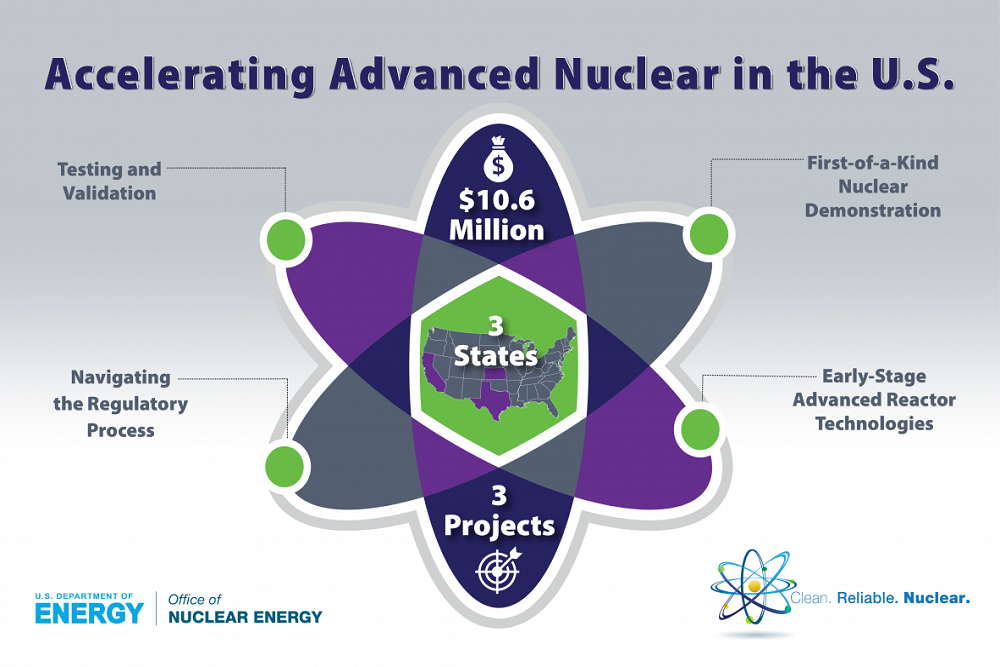U.S. Department of Energy issued the following announcement on May 23.
The U.S. Department of Energy (DOE) today announced funding selectees for multiple domestic advanced nuclear technology projects. Three projects in three states will receive varying amounts for a total of approximately $11 million in funding. The projects are cost-shared and will allow industry-led teams, including participants from federal agencies, public and private laboratories, institutions of higher education, and other domestic entities, to advance the state of U.S. commercial nuclear capability.
The awards are through the Office of Nuclear Energy’s (NE) funding opportunity announcement (FOA) U.S. Industry Opportunities for Advanced Nuclear Technology Development. This is the fourth round of funding through this FOA. The first group was announced on April 27, the second group was announced on July 10, the third group was announced on November 13, 2018, and the fourth groupwas announced on March 27, 2019. The total of the five rounds of awards is approximately $128 million. Subsequent quarterly application review and selection processes will be conducted over the next four years.
“There are a lot of U.S. companies working on technologies to make the next generation of nuclear reactors safer and highly competitive, and private-public partnerships will be key to accomplishing this goal,” said U.S. Secretary of Energy Rick Perry. “The Trump Administration is committed to reviving and revitalizing the U.S. nuclear industry, and these partnerships are needed to help successfully develop innovative domestic nuclear technologies.”
The solicitation is broken into three funding pathways:
- First-of-a-Kind (FOAK) Nuclear Demonstration Readiness Project pathway, intended to address major advanced reactor design development projects or complex technology advancements for existing plants which have significant technical and licensing risk and have the potential to be deployed by the mid-to-late 2020s.
- Advanced Reactor Development Projects pathway, which allows a broad scope of proposed concepts and ideas that are best suited to improving the capabilities and commercialization potential of advanced reactor designs and technologies.
- Regulatory Assistance Grants pathway, which provide direct support for resolving design regulatory issues, regulatory review of licensing topical reports or papers, and other efforts focused on obtaining certification and licensing approvals for advanced reactor designs and capabilities.
The following two projects were selected under the Advanced Reactor Development Projects pathway:
- Advanced Remote Monitoring – Under this proposal, Utilities Service Alliance, Inc. (Overland Park, KA) is to research, develop, and deploy automation and advanced remote monitoring technology into the United States nuclear fleet to achieve economic viability while maintaining or improving safety and reliability.
DOE Funding: $9,183,255; Non-DOE: $4,081,445; Total: $13,264,700
- STPNOC FIRE PRA 2019 – Under this proposal, STP Nuclear Operating Company (Wadsworth, TX) is to develop and implement advanced Fire PRA modeling techniques that will remove existing conservatism and lead to realistic models to be used in the nuclear industry.
DOE Funding: $942,477; Non-DOE: $235,619; Total Value: $1,178,096
The following project was selected under the Regulatory Assistance Grant pathway:
- Software Verification and Validation Guidelines for Nonlinear Soil-Structure Interaction Analysis to Enable Cost-Effective Advanced Reactor Design - SC Solutions (Sunnyvale, CA) will develop a nonlinear soil-structure interaction analysis software verification and validation guidance document as a critical tool to facilitate cost reductions in nuclear plant licensing and construction.
DOE Funding: $470,483; Non-DOE: $117,621; Total Value: $588,104
NE funds research, development, and demonstration projects to reduce the risk and cost of advanced nuclear technologies, and to improve nuclear energy’s contribution to meeting the nation’s economic, energy security, and environmental challenges. More information on the Office of Nuclear Energy and its programs can be found here.
Original source can be found here.


 Alerts Sign-up
Alerts Sign-up